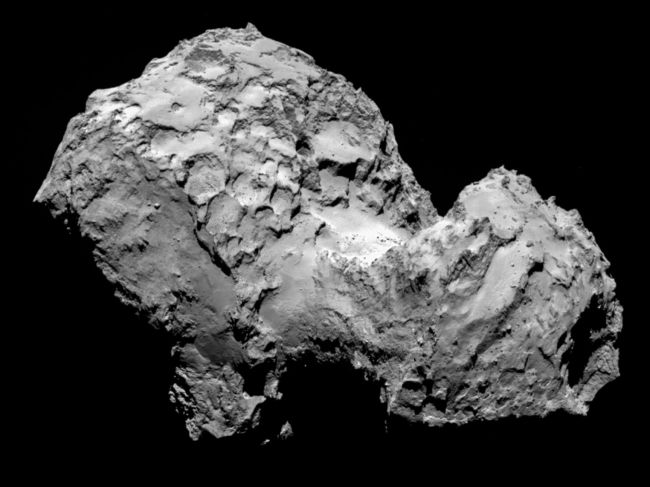[Newsmaker] Space probe makes rendezvous with comet
By Korea HeraldPublished : Aug. 7, 2014 - 21:14
PARIS ― The space probe Rosetta made a historic rendezvous with a comet on Wednesday, climaxing a 10-year, 6-billion-kilometer chase through the Solar System, the European Space Agency (ESA) said.
“We’re at the comet,” Rosetta’s flight operations manager, Sylvain Lodiot, declared in a webcast from mission control in Darmstadt, Germany.
It marks the first time a spacecraft has been sent into orbit around a comet, a wanderer of the Solar System whose primeval dust and ice may hold insights into how the planets formed.
In November, a robot scientific lab called Philae will be sent down to the surface to make the first-ever landing on a comet.
Rosetta’s rendezvous with Comet 67P/Churyumov-Gerasimenko was confirmed at 0929 GMT at distance of 400 million km from Earth, according to signals received at ground stations.
“We’re at the comet,” Rosetta’s flight operations manager, Sylvain Lodiot, declared in a webcast from mission control in Darmstadt, Germany.
It marks the first time a spacecraft has been sent into orbit around a comet, a wanderer of the Solar System whose primeval dust and ice may hold insights into how the planets formed.
In November, a robot scientific lab called Philae will be sent down to the surface to make the first-ever landing on a comet.
Rosetta’s rendezvous with Comet 67P/Churyumov-Gerasimenko was confirmed at 0929 GMT at distance of 400 million km from Earth, according to signals received at ground stations.

ESA Director General Jean-Jacques Dordain hailed the fruit of 20 years’ work to design, build and launch the three-tonne craft and then steer it to a tiny target in deep space.
“It makes 2014 the year of Rosetta,” he said.
“Rosetta is a unique mission, unique by its scientific goal,” Dordain said.
“Understanding our origins is certainly the best way to understand our future.”
On its Twitter page, the Rosetta mission said “Hello, comet!” in each of the languages of the agency’s 20 nations.
“It’s a historic meeting and a great first in world science, which the global space community has been awaiting for a decade,” said Jean-Yves Le Gall, president of France’s National Center for Space Research, a major contributor to the project.
ESA showed a close-up picture of a gnarled, greyish object, which rotates on its side once every 12 hours, comprising two lobes joined by a neck ― a feature that made it look rather like a rubber duck.
The surface is pocked by what seem to be impact marks.
Project scientist Matt Taylor said the unexpected shape could have come from two comets that joined together, or perhaps from a single object that eroded dramatically over time.
Mark McCaughrean, an ESA senior science adviser, cautioned that the images had been digitally brightened, for the comet was extremely dark.
“It’s blacker than fresh asphalt ... an incredibly dark, gray object,” he said.
Launched in March 2004, Rosetta had to make four flybys of Mars and Earth, using their gravitational force as a slingshot to build up speed to catch up with its prey.
It entered a 31-month hibernation as light from the distant Sun became too weak for its solar panels. The slumber ended in January with a wake-up call sent from Earth.
It then began a complex series of manoeuvres to slow down to walking speed with the comet.
If any one of those operations had failed, the probe would have gone whizzing past its target.
The final manoeuvre was a small firing of thrusters, lasting just six minutes and 26 seconds, which placed Rosetta on a triangular orbit around the comet at a height of about 100 kilometers.
Rosetta will gradually reduce altitude, entering gravitational orbit in September, as scientists search for a landing site for Philae.
Comets are believed by astrophysicists to be ancient ice and dust left from the building of the Solar System around 4.6 billion years ago. This cosmic rubble is the oldest, least-touched material in our stellar neighborhood.
Understanding its chemical ID and physical composition will give insights into how the planets coalesced after the Sun flared into light, it is hoped.
It could also determine the fate of a theory called “pan-spermia,” which suggests comets, by smashing into the infant Earth, sowed our home with water and precious organic molecules, providing us with a kickstart for life.
The four-km comet returns around the Sun on an egg-shaped orbit every six and a half years, its furthest point being beyond Jupiter. (AFP)
-
Articles by Korea Herald

















![[KH Explains] Hyundai's full hybrid edge to pay off amid slow transition to pure EVs](http://res.heraldm.com/phpwas/restmb_idxmake.php?idx=652&simg=/content/image/2024/04/18/20240418050645_0.jpg&u=20240419100350)

![[Today’s K-pop] Zico drops snippet of collaboration with Jennie](http://res.heraldm.com/phpwas/restmb_idxmake.php?idx=642&simg=/content/image/2024/04/18/20240418050702_0.jpg&u=)